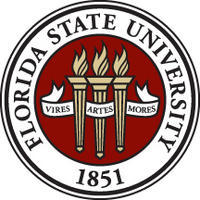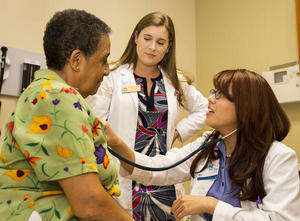FSU colleges collaborate to pave smoother pathway into health professions

Every year, thousands of new students arrive at Florida State hoping to enter a career in health care. For a variety of reasons, most of these would-be physicians, nurses, pharmacists and others wind up in different careers — and communities lose out on the health care they could have provided.
In an effort to turn that trend around, fully half of FSU’s colleges, including the College of Arts and Sciences, are working together to create a student-friendly pathway into the health professions. Called (IMS for short), it’s unlike anything else in the country — and with the provost’s blessing, it’s on a super-fast track.
Students are taking part in orientation sessions this summer. The curriculum is being fine-tuned for the fall semester. And hopes are running high.
“It’s an exciting moment for Florida State,” said Provost Sally McRorie. “We will vigorously pursue this innovative approach to preparing students and helping them find jobs in medical fields. I predict we will become the destination for students from Florida who want access to the full range of health professions.”
Most of the program’s courses already exist, though some are being revised with pre-health students in mind. The biggest change is in the way the students are guided along the pathway — and in the sense that the participating colleges are all working together as program partners.
Some universities have premed programs, College of Medicine Senior Associate Dean Myra Hurt said, but they’re not as flexible, all-encompassing or student-centered as this one.
“There’s no straightforward path to figure out, ‘Do I really want to go into the health professions?’” said Hurt, who conceived this idea in 2012. “Eventually we’ll see such a difference in how students feel about the path they’re on.”

A patient is examined by a College of Medicine alumna and student.
Representatives from seven colleges served on a task force charged with getting IMS off the ground: Arts & Sciences (Departments of Biological Science, Chemistry and Biochemistry, and Psychology); Communication and Information; Human Sciences; Medicine; Nursing; Social Sciences and Public Policy; and Social Work. In addition, students from the College of Business will be conducting case studies to determine the best way to recruit the right students as well as employers.
Universities everywhere are wrestling with the same challenge. Four years ago, Hurt helped lead a Harvard Macy Institute session where participants from around the world focused on creating an interdisciplinary path to medical school. Hurt, the driving force behind the creation of FSU’s medical school, is no stranger to big ideas. She immediately started wondering how she could adapt this one for FSU. She ran her ideas past several people but got nowhere — until McRorie became provost.
“We’re going to do this,” McRorie said.
The timing was good. FSU needed to boost its total number of STEM (science, technology, engineering and math) graduates; cut the time to graduation; and increase the number of graduates getting jobs with good salaries.
Here’s a sampling of what IMS offers students:
- Choice of three majors. The pathway has three branches: Pre-Professionals, including physicians, nurses, physician assistants and pharmacists; Patient Care in the Community, including social workers, patient navigators and health advocates; and Health Policy and Technology, including social scientists and health informaticists.
- Core sciences for everyone. During the first two years, every IMS student will take the core sciences. “When you finish this,” said Associate Dean Helen Livingston, Hurt’s go-to curriculum planner, “you have a fundamental basis for any field in health care, wherever you go.”
- Real-world experiences. Science is important, but it’s only part of the picture. So every student will have regular contact with health professionals in the community, through shadowing and seminars. They’ll get answers to key career questions: “What professions are available?” “Could I see myself doing this job?” “Hours? Income? Training required?” “What are the social and psychological components of being in health professions?”
- Flexibility. In the past, students sometimes chose a narrowly defined major without all the information they needed — then wasted time and money changing their major. Sometimes they ended up with a degree but no profession. The interdisciplinary approach provides new opportunities to take electives and explore options. “For example, there are a number of College of Human Sciences courses, like child development, that someone interested in pediatrics could take,” Hurt said. “That really wasn’t an option before.”
- Continual advising. Students don’t come to college equally prepared. Some get poor advising along the way. Some don’t cope well with life’s surprises. “So we hope to provide lots of guidance,” Livingston said. “Not just in an academic sense, but in terms of how they’re growing personally and professionally and helping them determine a career path.”
- Team-based approach. These future health professionals will work side by side, mirroring the real world’s increasing demand for collaboration.
Hurt predicts as many as 140 students will sign up this first year. One of those pioneers is Emilie Miller. Right now she hopes to become a physician assistant focused on pediatrics, but she appreciates IMS’ array of options.
“I had planned to major in nursing as a bridge to the career path I wanted,” said Miller, who graduated in May from Tallahassee’s St. John Paul II Catholic High School, but then her mom learned about IMS. “After reading the description, it was exactly what I was looking for. I am beyond excited to be a part of something so new and creative.”
In some cases, IMS has been an opportunity for departments to carry out changes they’d already been considering.
“Chemistry is called the ‘Central Science’ because it is so strongly tied to all of the physical and biological sciences, and students in each of these majors require a solid grounding in the basic principles of chemical structure and reactivity,” said Tim Logan, chair of the Department of Chemistry and Biochemistry. “These topics are currently taught in a framework that has worked well for generations. However, there is increasing awareness that the full traditional chemistry curriculum is not necessarily needed by non-chemistry students and, in particular, by premedical students. We are trying to accommodate changes in the education needs of premedical/pre-professional students by designing these new courses.”
Judith McFetridge-Durdle, dean of the College of Nursing, particularly likes the options IMS offers her students.
“As a limited-access major, the College of Nursing must turn away hundreds of qualified applicants each year,” she said. “The IMS program will allow students who are not accepted into the Bachelor of Science in Nursing Program at the end of their sophomore year to continue on and graduate with a degree from Florida State that will prepare them for a career in another health-related field.”
Late last month, Florida Gov. Rick Scott hosted a two-day Degrees to Jobs Summit. College of Medicine Dean John P. Fogarty thinks the IMS program fits right in.
“We want our graduates to be fully prepared to get jobs in this economy,” Fogarty said. “Even during the lowest part of the recent recession, health care was still a dependable career for employment. With this program, we can make sure that our students get a great education while meeting the health-care needs of our state and nation.”
IMS is based in the College of Medicine, and Hurt and Livingston will direct it. Hurt predicts that in five years, if things go well, there may be 800 IMS students. “Eventually,” she said, “it could be a lot. It could be a whole lot.”
